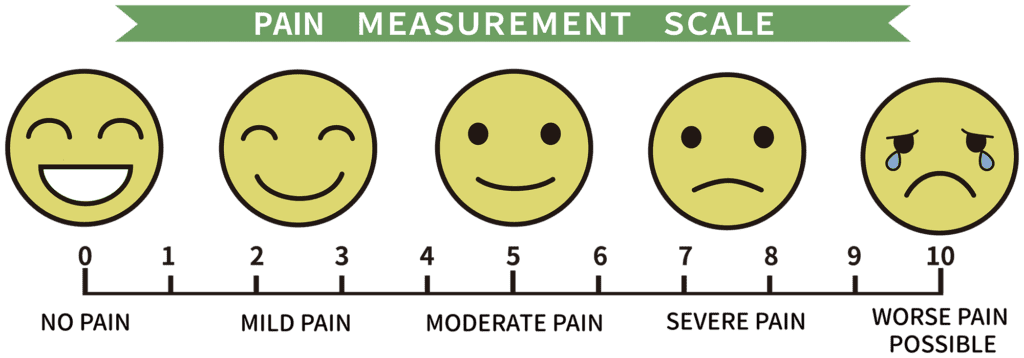What the Pain Scale May Be Telling You
You may have seen different types of pain scales in hospital or clinical settings. Many have rows of faces, beginning with a smiling face and ending with an expression of agony, as well as numeric scores that give you an idea of the range and intensity of pain. But how do you best communicate exactly which number or face on the pain scale to choose?
There are many nuances to pain, and perception of pain can be very different from one person to the next, according to IBJI Anesthesiologist and Pain Management Physician Brooke Vanderby, MD. In this blog post, she describes what pain scale ranges mean and discusses some of the different types of pain. She also shares how she pieces together clues to determine what may be causing your pain.

The Pain Scale and What It Means
Beginning at the far left of most pain scales, you’ll find a happy face and a score that begins with either zero or the numeral one.
“A 1 to 3,” Dr. Vanderby says, “represents mild pain. It’s something that might be a background pain that you may notice here and there, but it’s not preventing you from doing what you want to be doing.”
Moving upward on the scale, a 4 to 6 is a moderate pain that you might notice with certain movement or activity, but it’s not something that is constant.
From a 7 to 8 on the pain scale, you’re feeling more severe pain. “It starts to be more persistent during the day, and it’s starting to slow you down,” explains Dr. Vanderby. “It’s affecting your walking or your work or your concentration. It’s preventing you from doing tasks.”
Finally, a 9 to a 10 on the pain scale is considered an extreme pain reading. The face represented on the pain scale indicates unbearable pain. “This is pain that is not responding to anything you can do at home,” Dr. Vanderby says. “It’s untreatable with ice or heat or ibuprofen, needs strong pain medication, and in some cases has taken you to the emergency room.”
Types of Pain
Pain from different structures has different characteristics, so it can be helpful to describe pain to your doctor. Nerve pain, for example, tends to feel like a burning or electric or shooting sensation that can be more constant as opposed to something that is more of an arthritic pain, which can feel dull, achy, or sharp. “When people can differentiate something that is sharp, aching, or buzzing like pins and needles, it can be helpful to know. It can help me differentiate between arthritic joint pain and nerve pain.”
When Does Pain Occur?
Telling your doctor when you’re experiencing pain - something that is not on the pain scale - can give much-needed information that can give clues to what’s causing it. For instance, is it first thing in the morning but gets better as the day goes on? Does it hurt more when walking or standing but feels better when sitting down? Or does it feel worse when sitting down? “All of these questions help me to figure out the different structures that are causing the symptoms,” Dr. Vanderby says.
Dr. Vanderby sees a lot of patients who have spine-related pain, for example. “Typically, they get sharp shooting pain in their lower back which can radiate into their legs. It’s worse when they are walking and standing, but feels better when they sit down. Typically, they’ve tried ice and some topical analgesics, but haven’t been able to get any better.”
What Does a Pain Workup Look Like?
Dr. Vanderby says a patient presenting with back pain may receive a lumbar X-ray or MRI to help identify the problem area. From there, direct treatment can begin with either medication, physical therapy or injections. If surgery is needed, the patient would be referred to an orthopedic surgeon.
What Causes Pain?
Pain, and in particular chronic pain, is a complex condition. Despite decades of research it remains poorly understood and difficult to treat. Some causes of pain can be traced back to a specific injury, while other cases have no apparent cause. Many cases of chronic pain are related to low back pain, arthritis, especially osteoarthritis, headache, fibromyalgia, shingles or nerve damage (neuropathy).
What Does Your Physician Need to Know?
Dr. Vanderby says she asks her patients a series of questions to gather a pain history. Those questions can include the following:
- When did the pain start?
- Is it chronic pain?
- Was there a specific event when it started, such as an accident or a fall?
- Has it gotten worse over time?
- When is the pain felt - morning, afternoon, evening?
- How does it impact your day or activities?
- What does it feel like? Is it sharp, achy, stabbing, burning or electric?
- Where does the pain travel to or where do you feel it?
- What methods have you tried to alleviate the pain?
- Have you worked with a chiropractor or had any acupuncture?
- What was the result of the methods you have tried?
It can help to keep a pain log to answer these types of questions to better assist your physician in diagnosing and treating your pain.
When Is it Time to See a Pain Doctor?
Pain doctors, like Dr. Vanderby, can be a good starting point because of their ability to evaluate, conduct a proper workup, and order imaging to identify what’s causing pain, but more commonly, these specialized physicians are the end point. “Usually, people have had pain going on for a few months and have already seen their primary care or family physician,” Dr. Vanderby says. “They have tried a few things and they aren’t responding, so we’re a good next step as specialists.”
What Can a Pain Doctor Do for You?
Dr. Vanderby recommends a comprehensive approach to pain management and employs a variety of non-drug treatments for pain including nerve blocks, epidural and joint injections, radiofrequency ablation, muscle trigger point injections and nerve and spinal cord stimulation. She coordinates this with prescription medications, physical therapy and alternative remedies.
“Frequently, things can be improved,” Dr. Vanderby says. “After talking with the patient about the specific nature of the pain and the effectiveness of any treatments they have already tried, the right combination of treatments can be found to help them feel better and return to doing the activities they enjoy. “If exercise is an option, they can often improve with rehab, and interval injections can be enough to get the patient back to where they need to be.”
How Can Patients Better Communicate Pain to Their Doctors?
Besides communicating a pain scale score, being prepared ahead of the appointment with a good pain history is important, she says. “It always helps to have questions written out and ready so we can make sure to answer them.”
Next Steps
Feeling pain? If you would like to be evaluated, you can schedule online with an IBJI pain management physician who can help you with a diagnosis and treatment plan to get you back to feeling your best.



.jpg)
